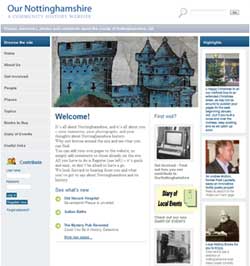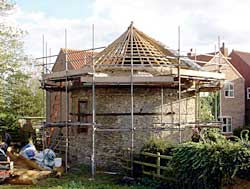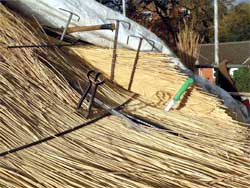News for Winter 2011
THE THOROTON SOCIETY RESEARCH GROUP
By John Wilson
The second meeting of the Group was held at Arnold Library on Saturday, 22 October 2011.
The Great War Centenary 2014 The members were joined by Mark Dorrington, Principal Archivist at Nottinghamshire Archives. Mark informed the Group that the Libraries, Archives and Information Service were considering publications for the centenary of the Great War in 2014. Around three publications were funded each year by the County Council. The Research Group had been considering such a publication and it was agreed that we should collaborate in some way.
Members' Research Work in Progress Rachel Farrand talked about some of her current work on war memorials from the Great War and indicated some areas that needed further study. Some, such as the Dakeyne Street Lad's Club memorial, had connections with important local families. This research could form part of the proposed publication on the Great War.
Rachel pointed out that many churches had been demolished in recent years and their
memorials, including war memorials, had been lost. Others had been moved from their original locations. A member suggested that stonemasons' records, where they had survived, might give a clue as to the original locations of war memorials.
John Wilson described a study that compared infant death rates from diarrhoea in Nottingham between 1905 and 1916, when most homes had pail closets, with the death rates during 1923-26, when all homes in Nottingham had been converted to water closets. Up to 1916, there was a clear positive correlation between numbers of infant deaths from diarrhoea over the summer/autumn period and the number of warm or hot days in the summer. After all homes had been converted to water closets, there was no such correlation.
It was suggested that a similar study of the weather and public health during the years of the Great War could be part of the proposed publication. John also showed a chart of influenza deaths in 1919 and 1923, and pointed out that the less severe influenza epidemics post-1919 had not, to his knowledge, been studied. The latter could form a small research project.
HAPPY ANNIVERSARY- NOTTINGHAM CIVIC SOCIETY
The Nottingham Civic Society celebrates its 50th anniversary in January 2012. The following notice appeared in the Nottingham Guardian Journal on 12 September 1961:-
'A Civic Trust is urgently needed in Nottingham to preserve the archaeological and historical interest of the city', said Mr. M. W. Barley, senior tutor in archaeology and local history for the Extra Mural Department of Nottingham University.
Mr. Barley, honorary secretary of the Council for British Archaeology told Nottingham Rotary Club members at their lunchtime meeting yesterday that Nottingham is in danger of losing buildings and streets of historical interest if some kind of civic trust is not formed.
He said he would like to see the Nottingham Corporation employ someone on the staff of the Castle Museum who would make it his business to ensure that nothing of archaeological interest is lost. After the meeting, Mr. Barley told reporters:
"There are sufficient rate-payers in Nottingham who would be interested in supporting me in this matter".
Mr. Barley revealed that a group of undergraduates are to arrange a meeting at the end of the month to discuss ways and means of protecting archaeological discoveries. He explained that the Thoroton Society in Nottingham are doing all in their power to see that nothing of historical interest is lost. "They are doing a fine job," he said, "but I still feel that some official civic trust should be set up in the city." Mr. Barley also said it was time Nottingham had a good historical museum. "Leicester spends twice as much on its museum services as Nottingham," he said, "but I must admit that it does not spend so much on a civic theatre."
The inaugural meeting of the Civic Society was held on 11 January 1962 and Mr. Barley was elected Chairman. The new Playhouse opened on 11 December 1963.
Ken Brand
THE SATURDAY SEMINAR SERIES
This popular series of talks held on Saturday mornings from 10 am to around 12.30 pm continues with the following talks advertised. The events are held at the University of Nottingham's Department of History at Lenton Grove on the main campus. The admission at £5 includes coffee/tea and biscuits at the interval and beverages are available prior to the commencement of the talks at 50p a cup.
14 January 2012, Researching Nottinghamshire's Architectural History by ELAINE HARWOOD of English Heritage
11 February 2012, Going Local with the National Trust by BEN COWELL of the National Trust
10 March 2012, The South Oxfordshire Project: Perceptions of Landscapes, Settlement and Society, C500-1650 by STEPHEN MILESON of the VCH and editor of the Oxoniensia journal.
Full details from Professor Beckett at john.beckett@nottingham.ac.uk
A VOLUNTEERING OPPORTUNITY AT NOTTINGHAMSHIRE ARCHIVES
It is three years since NAWCAT (Nottingham Archives Worldwide Catalogue) went live on the web. It currently holds over 15,000 catalogue entries but this only represents a small percentage of the catalogues of the total holdings. There are still 47 years worth of catalogues to add to the web ... and this is where volunteers are needed to help. The Archives are looking for volunteers for two projects:
1. Retro-conversion of catalogues
Volunteers are required to input earlier catalogues onto Excel databases which can then be transferred onto NAWCAT; training on the entering of the data will be given.
2. Data entering of bishop's transcripts catalogues
Between 2005 and 2010, a group of volunteers listed all the bishop's transcripts (contemporary copies of the parish registers). The resultant catalogue for the earliest series, from c1600 to 1815, again needs entering onto Excel so that it can be transferred to NAWCAT. The earlier series have already been entered and can be viewed on-line on the web site at http://nawcat.nottinghamshire.gov.uk under references DR/1/6 for the years 1813 to 1835 and DR/1/7 for 1836 to 1902.
To date the present volunteers have worked at Nottinghamshire Archives but for these projects people are sought to work at home or in their local library. Volunteers don't even have to live locally; the Archives will happily post the necessary paper catalogues to be worked upon.
If anyone has an interest in history or even wants to update IT skills this could be the volunteer project to take up.
If interested please contact Nottinghamshire Archives, County House, Castle Meadow Road, Nottingham, NG2 1 AG (tel: 0115-950-4524) to request an application form. Alternately forms are available to download from the website at www.nottinghamshire.gov.uk/archives
NEW WEBSITE FOR LOCAL HISTORY
By David Bagley

The Nottinghamshire Loves Learning Partnership which includes the City and County Library Service and Nottinghamshire Archives, launched its new website on 11 October. The meeting at Arnold Library was introduced by John Holmes, the BBC local history front man who reminisced about the 'old days' in researching local history items (i.e. only few years ago and in pre-Google time!). Then his preferred approach was to ring a local Post Office to ask which local individual could be contacted.
The new website - ournottinghamshire.org.uk - is presented as an easy to use and very interactive source of information about all aspects of heritage in the county. It incorporates familiar sources such as Picturethepast which accessed the Library Service's file of photographs and extends this to cover broad headings of Topics, Places, Books to Buy and Diary of Events. This last section will be of interest to all Local History societies since it offers the chance to include all planned talks and events, hitherto only available through the quarterly Nottinghamshire Historian.
The entire site is intended to be interactive; each page providing for comments to be added which can enhance or extend the information presented, in a manner similar to Wikipedia on Google. Comments will be scrutinized by the editorial team and will add to rather than replace the main text.
Initially, the contents seem to be limited to what is already available in Library Service files but it is hoped that all local history groups and individual researchers will rapidly contribute to make the site a valuable resource. At the very least links to other larger databases can be included.
Although the organisers invited all Local History Societies to attend the inaugural meeting (ours didn't apparently receive an invite, ed.) they seemed to forget about the Thoroton Society, but there is a link to the Nottinghamshire Gateway on the site.
THE DOVECOTE AT THOROTON


The Thoroton dovecote under renovation.
The Nottinghamshire Building Preservation Trust has owned the Grade 11 listed dovecote at Thoroton for 22 years and, in October 2011, was delighted to announce that restoration work has begun which will result in one of the county's few surviving medieval dovecotes being open to the public.
Months of research, negotiations and planning have enabled the work to commence and the Trust acknowledges a grant from Nottinghamshire County Council's Local Improvement Scheme, and an earlier donation by County Councillor Martin Suthers OBE from his Electoral Division Initiative Fund. The balance will be provided by the Trust's own Dovecote Fund.
Restoration work is ongoing and the next step is a radar survey to identify any weaknesses in the external walls. The whole project is being coordinated by architect Alan Wahlers, one of the Trust's volunteer technical experts. Essential to the success of the project has been the help and co-operation of the owner of the paddock, and of the garden of the residential building across both of which the dovecote is built.
On Friday, 21 October, master thatcher Roger Scanlan of Spratton, Northamptonshire, and two craftsmen showed NBPT officers, local residents and some supporters, how the work was being done. The old water reed thatch is being replaced on a 'like for like' basis. Longer lasting than straw, 6-7 feet tall water reed is uniform in length; its tapering growth making it ideal for thatching. It sheds water very efficiently, has no seeds to attract vermin and can be packed close so birds cannot penetrate. An ornamental block cut ridge of sedge and straw will seal the apex.
The dovecote was granted listed status in 1965 when it still housed pigeons in the 480 boxes which remained intact. It belonged to Thoroton Hall and stood in the stackyard of Ransoms farm. Its future was put in jeopardy in 1989 when plans to build on part of the farm were made and its acquisition by the Trust certainly saved it from possible demolition. It was probably built in the 14th century and is the only thatched example of a dovecote left in Nottinghamshire. Originally it had about 600 nesting boxes built into the massive stone walls and the pigeons it housed provided year round meat for the pot, eggs, manure and even possibly saltpetre for explosives in the 16th and 17th centuries. The birds, called squabs, were eaten before they fledged at about six weeks old and weighed 12 - 14 ounces. They were particularly useful during winter. It is suggested that by the 18th century when farmers began to grow the humble turnip, livestock could be fed throughout the winter and so pigeons lost their importance and dovecotes began to fall out of use. Before this, non-breeding livestock was frequently slaughtered in the autumn when it could not be fed through the winter period, the meat was smoked and pickled.
It is really good to see this dovecote receiving the care and attention that it warrants and it will be especially good to see it open for public examination in the course of time.
Snippets
JOHN HAMILTON, who members will; know has gone to dwell in the south found the following inscription on a monument inside the church of St. Lawrence on the Isle of Thanet:
Haud procui hinc situs Petrys THOROTON L>L>B>, Ecclesiarum de Colwicke et West Bridgeford in agro Nottinghamiensi, Rector, ecclesiae Collegiatae de Wolverhapton Prebendarius. Natus est A>D> MDCCLXill, Decessit A. D. MDCCCXVii. Compositum jus, fasque animo, santosque recessus mentis, et incoctum generoso pectus honesto.
WORLD'S LONGEST WEATHER RECORD
A recent report on the BBC website says that a retired meteorologist has spent 20 years producing what he believes to be the world's lengthiest weather record.
Jim Rothwell, 80, from Southwell has gathered data for Central England from 56 BC to the present day, using more than 40 different data sources. Painstaking work cross-checking sources he has produced a climatic profile for each month back to 1659. Between 1167 and 1659 there are reports for each summer and winter but beyond that information is rather sporadic.
Mr. Rothwell will donate his records to the Nottinghamshire Archives and the national Met Office but he will continue to add to his data.
THE ALAN BALL LOCAL HISTORY AWARD
Congratulations to Nottinghamshire County Council for winning the 2010 Alan Ball Local History Award for Dr. Stuart Jenning's book, These Uncertain Tymes, Newark and the Civilian Experience of the Civil Wars 1640-1660. The award is administered by the Library Services Trust, and is given to encourage local history publishing by public libraries and local authorities.
Mr. Michael Saich, Chairman of the Library Services Trust, presented the award to Councillor Keith Walker, Chairman of the County Council, at a brief ceremony held in Nottinghamshire Archives on 12 October 2011. Also present was Councillor Kay Cutts, leader of the County Council, and Professor Martyn Bennett, who supervised Dr. Jenning's original thesis on civil war Newark. Stuart Jennings said a few words about his work, and guests were invited to inspect a small display of the archives used in the book.
John Beckett
LOCAL NEWSPAPERS PRINTED OUTSIDE THE EAST MIDLANDS
Terry Fry's fascinating article about local newspapers resonated the other day when it was announced that the Derby Telegraph and Nottingham Post are now being printed outside the region in Birmingham. Northcliffe Media owns both papers and also the Lincolnshire Echo which was relaunched in October as a weekly edition after the 118 year run of daily editions was ended.
VICTORIA COUNTY HISTORY
Recently announced by VCH is that Nottinghamshire workshops under the guidance of Philip Riden commenced on 4 October, contact is Philip.Riden@nottingham.ac.uk or 01246-554026. Work-in-Progress is announced on Normanton-on-the-Wolds, Clipston and Plumtree.
BROMLEY HOUSE
Showing until 9 December at South Nottingham College, Clifton, is an exhibition of photographs from the Julia Margaret Cameron Trust on the Isle of Wight. The exhibition is part of the campaign to raise awareness and funds for the restoration of the photographers' studio at Bromley House.
This is a rare opportunity to see seminal images tracing the history of photography through the years and really is an exhibition not to be missed.
NEWSTEAD ABBEY
The New York based World Monuments Watch has recently placed Newstead on a list of 67 of the World's most treasured sites which the organisation believes must be saved.
Nottingham City Council reacted by welcoming the inclusion on the list and was hopeful that it could lead to partnership opportunities.
CLUMBER PARK
A new visitor centre has recently opened at Clumber Park facilitated by a lottery grant of £797,000. The new Discovery and Exhibition centre is housed in the former Brewhouse at the park and features interactive displays which help visitors learn more about the park and its wildlife.
METAL BOX, MANSFIELD
An exhibition running until 7 January 2012 at the Leeming Street Museum in Mansfield celebrates the story of the company and its former Rock Valley factory through hundreds of tins, original artwork, photographs and interviews with former employees. This should be an most interesting exhibition to visit.
MEDIEVAL TREASURE TO BE OPENED TO PUBLIC VIEW
The 15th century Wollaton Antiphonal, the most stunning of the medieval manuscripts cared for at the University of Nottingham, is to be made available to the public using the Turning the Pages technology pioneered by the British Library.
A research grant from the Art and Humanities Research Council awarded to Emeritus Professor Thorlac Turville-Petre (School of English Studies), is enabling the creation of a virtual edition of about 40 openings, including all the richly-decorated folios. The project team is based in the Manuscripts and Special Collections Department of the University of Nottingham.
Details about the volume's preservation history will be shown in the virtual publication. A touchscreen kiosk will be installed in Wollaton church, enabling visitors to browse the manuscript and a later on-line version will open the book to more distant readers.